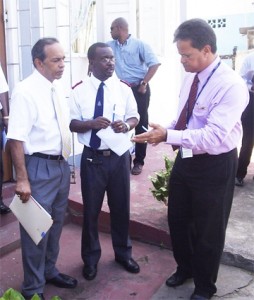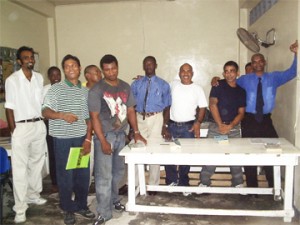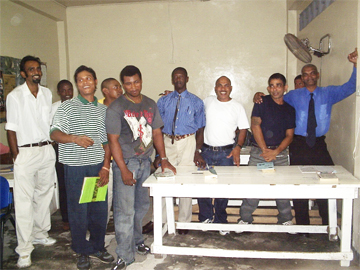Chairman of the Private Sector Commission Captain Gerald Gouveia has pledged to take the concerns of the Salvation Army’s Drug Rehabilitation Centre “to the highest level.”
Gouveia made this commitment during a tour of the institution last week, and said the business community should take up the opportunity to help this most worthy cause. The visit was part of an initiative by the management of the centre to get the business community involved in the work they do.

The centre is short of funds and this was made clear during the visit. Financial constraints are the main reason why the rehabilitation unit only caters for men, and why its accommodation is limited to 21 persons for the six-month period the programme lasts. Some of the men are supported by their families while those who cannot afford the fee of $50,000 per month are assisted partly by the government. At the moment there are 20 addicts at the centre, seven of whom are government sponsored.
Divisional Commander of the Salvation Army, Major Sinous Theodore, said they were trying hard to get a programme going for women addicts too, but had not been able to do so. The major acknowledged that a mere 21 persons did not represent the total number of persons who were plagued by addiction, but that the centre was doing its best with the available resources.
Chairman of the Board of the Salvation Army Edward Boyer spoke of the need for counsellors at the centre. He said the number of volunteer counsellors was insufficient to deal with all the cases there, and that persons who thought they were capable of offering care and advice to the addicts could volunteer their services.
Kirk Jardine, popularly known as ‘Chow Pow’ is a recovered addict who now leads a fulfilling life by offering counselling to the men who are going through what he once did. Jardine said that contrary to reports that only 1% of addicts come out on the other side, there has been a 60% success rate in the programme over the last two years.

He emphasized the need for guidance for the men, since as he knew from experience the journey to recovery was not an easy one.
The centre tries to help recovered addicts after they have finished the programme by providing a half-way house. Following their six months’ treatment, men who have got a job and are ready to move on with their lives can stay in separate dorms there. Jardine explained that this gives them a place to stay where they will not be under the direct influence of the company they had kept before rehabilitation. It costs $10,000 per month to stay in the halfway house.
The rehabilitated addicts are not left on their own even after the programme is over, but are asked to check in with the centre at specific times. Management also tries to keep in contact with them by calling them regularly.
Jardine as well as Boyer stressed the need for support for the addicts after the programme has been completed, something which in some cases is not forthcoming from families which may have been caused pain by the addicts.
Emphasising that drug addiction affects a person for life, Jardine said that they encouraged the men to examine their lives and tried hard to point out the areas where they were most seriously affected and then asked them to address these. The centre encourages the men to keep in contact with them for help in this area.
Meanwhile the men themselves admitted that the road to recovery was not an easy one.
“My desire to stop smoking made me come here,” Leonard told reporters last week. Speaking into the cameras the man said that he was a seaman and he used to spend thousands of dollars a day to feed his habit. “When I didn’t get money I would thief,” he said, and that was how he got shot, an incident which propelled him to the centre. “I was killing myself slowly,” another man who said he was a trained technician told reporters.
Nigel, another recovering addict, said that he had been in the programme before but had relapsed. He had not given up though, and was there once more. He said that he had visited the Stabroek Market recently, a place he described as his “grounds.”
“I saw de pusher and some of my friends,” he said “but I stayed strong.” Nigel said that he needed the support of his family but acknowledged that he had hurt them and was “allowing them time to heal.”
The rehabilitation centre was started back in 1996 by a Jamaican soldier who saw the need for it.
Meanwhile, next Friday the centre will launch a ‘Christmas Appeal’ at the Georgetown Club in another bid to acquire much needed funds.
Recently a rehab centre for women was opened at Mon Repos on the East Coast of Demerara. Built at a cost of $20M, the funding came from the US State Department’s International Narcotics Legal Affairs Unit (INL) and Catholic Relief Services (CRS).

